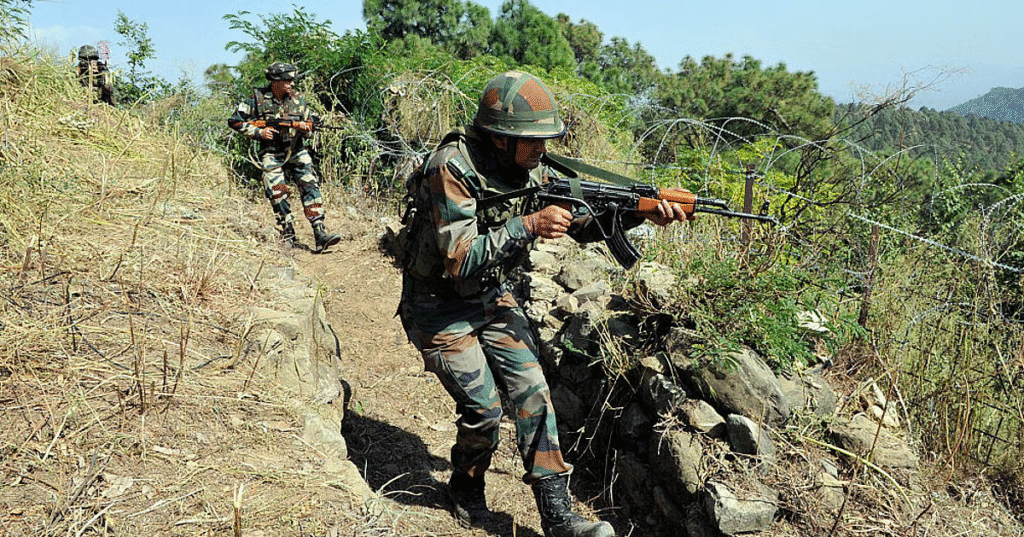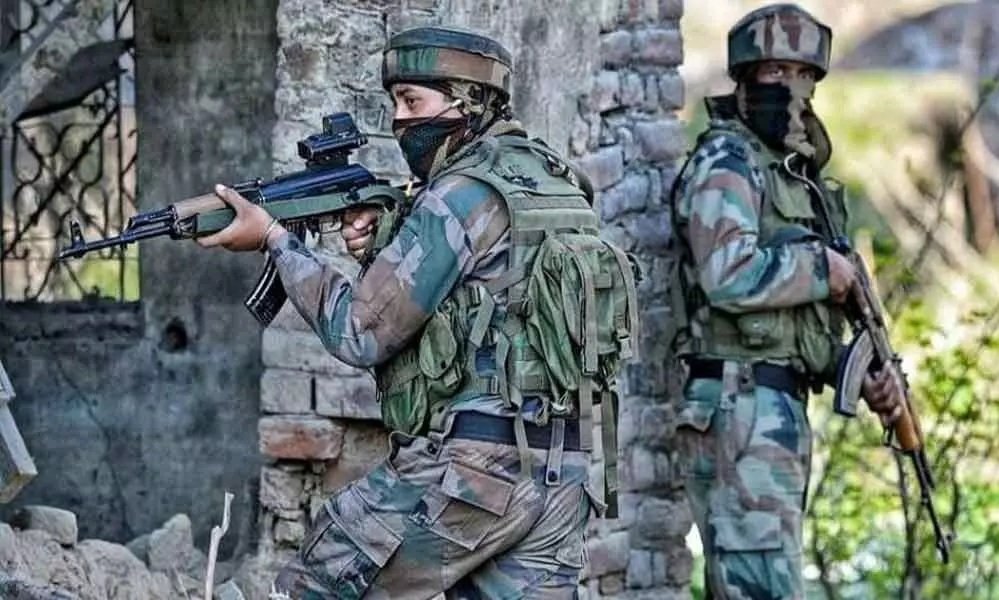The restive region of South Kashmir witnessed another violent flashpoint in its decades-long conflict as an unidentified militant was killed in a fierce gun battle with Indian security forces. The incident, which took place in the Pulwama district—a hotspot for militancy in the Union Territory of Jammu and Kashmir—underscores the ongoing tensions South Kashmir Gun Battle: and complex security dynamics at play in the region.
This article presents a comprehensive view of the gun battle in South Kashmir, its backdrop, operational details, implications, and what it signals for the security and civilian landscape going forward.

The Incident: A Timeline of the Gun Battle
Initial Intel and Launch of Operation
On the early morning of [insert date], based on specific intelligence inputs regarding the presence of armed militants, a joint team of the Indian Army, CRPF (Central Reserve Police Force), and Jammu and Kashmir Police launched a cordon-South Kashmir Gun Battle: and-search operation in the Pulwama district of South Kashmir.
The targeted area, known for thick orchards and narrow lanes, was cordoned off to prevent the escape of suspects. As security personnel closed in on a suspected hideout, they were met with gunfire, prompting a retaliatory response South Kashmir Gun Battle: and triggering a gun battle that lasted several hours.
Confirmation of Casualty
By afternoon, the encounter resulted in the killing of one militant, who remains unidentified at the time of reporting. Arms, ammunition, and incriminating material were recovered from the site. Security officials believe that the militant was likely affiliated with one of the Pakistan-backed terror groups operating in South Kashmir Gun Battle: the region, though confirmation awaits forensic analysis and identification.
Understanding the South Kashmir Militant Landscape
South Kashmir—comprising districts like Pulwama, Anantnag, Kulgam, and Shopian—has long been the epicenter of insurgency in the valley. Over the years, it has seen South Kashmir Gun Battle: the rise of homegrown militancy, coupled with infiltration from across the Line of Control (LoC).
A Shift in Militancy Trends
While earlier decades saw a dominance of foreign militants from Pakistan, recent years have witnessed the emergence of local youths taking up arms, often radicalized through digital propaganda. Groups like Lashkar-e-Taiba (LeT), Jaish-e-Mohammed (JeM), and The Resistance Front (TRF) have been active South Kashmir Gun Battle: in these parts.
The gun battle in Pulwama is not an isolated incident, but part of a larger, ongoing effort by Indian forces to flush out terrorist networks and restore peace in the region.
Security Forces’ Strategy and Execution
The latest operation in South Kashmir reflects a refined counter-insurgency strategy employed by Indian security forces, focusing on precision intelligence, rapid deployment, South Kashmir Gun Battle: and minimal civilian disruption.
Zeroing In on Targets
The operation was launched based on real-time, actionable intelligence. Over the past few years, the use of technology, human intelligence networks (HUMINT), and drone surveillance has drastically improved the accuracy of such missions.
Coordination Among Forces
The successful neutralization of the militant was made possible due to high-level coordination between the Indian Army’s Rashtriya Rifles, local police units, and the CRPF. Each unit plays a specific role—cordoning, engaging, backup, and evacuation, if needed.
Post-Operation Protocol
Once the militant was neutralized, standard post-operation protocols were followed, including:
- Sanitization of the area for booby traps or IEDs.
- Recovery and documentation of arms and evidence.
- A forensic sweep for identity verification and potential links to terror networks.
Civilian Safety and Ground Realities
Evacuation and Minimal Collateral Damage
Authorities ensured that civilians were evacuated safely from nearby homes before the gunfire began. No civilian casualties were reported, a critical measure of success in counter-insurgency operations aimed South Kashmir Gun Battle: at winning local trust.
Mobile and Internet Restrictions
As a preventive measure to stop the spread of misinformation and control public gatherings, mobile internet services were temporarily suspended in the Pulwama region. This has become a standard operating procedure in Kashmir following South Kashmir Gun Battle: any militant encounter.
Political and Security Reactions
Official Statements
Senior officers from the Jammu and Kashmir Police stated that the operation was part of an ongoing effort to dismantle militant infrastructure in South Kashmir. They reiterated their commitment to maintaining peace South Kashmir Gun Battle: and lauded the bravery of security personnel.
Union Ministry of Home Affairs Response
The Ministry of Home Affairs (MHA) acknowledged the encounter and noted that such operations are part of India’s zero-tolerance policy towards terrorism. They emphasized the importance of continued vigilance and intelligence gathering in the region.
Local Reactions and Impact on Daily Life
Public Sentiment
Public reaction in the valley remains mixed. While many civilians express relief over the neutralization of militants, others—especially in rural areas—grapple with the fear of being caught in crossfire or subjected to sudden searches.
Educational Institutions and Markets
Following the gun battle, schools and markets in the area remained closed for the day as a precaution. Authorities have since resumed normalcy, but the psychological toll on children and daily wage earners cannot be underestimated.
Media Coverage and Misinformation Challenges
Role of Responsible Journalism
Major news networks and regional digital portals provided timely and accurate updates, mostly relying on official statements. However, the risk of fake news and social media rumors remains a persistent challenge, especially in conflict zones.
Combatting Propaganda
Officials have urged the public to verify news from credible sources and discouraged the sharing of unverified images or videos from the encounter site, which can be exploited by radical elements for propaganda.
The Bigger Picture: Terrorism in Transition
This gun battle is part of a larger evolution in terrorism in the region.
Hybrid Militants and Lone-Wolf Attacks
Security agencies now deal with ‘hybrid militants’—individuals who lead normal lives but carry out isolated attacks before returning to anonymity. These actors are hard to track and pose a fresh challenge.
Cross-Border Influence
Despite improved surveillance and fencing along the LoC, infiltration attempts backed by Pakistan’s ISI continue, with some success. Militants are often trained across the border and provided logistical support upon entry into the Indian side.

Future Outlook and Preventive Strategies
Community Engagement
Winning the war against militancy is not just about guns and bullets. Community policing, deradicalization programs, and youth engagement initiatives are proving vital in dissuading young people from joining terror outfits.
Technology and Surveillance
Use of facial recognition, data analytics, and AI-based predictive modeling are gradually being integrated into operations to predict and prevent attacks.
Political Stability and Policy Focus
The government’s continued efforts to normalize Kashmir’s political environment post-Article 370 abrogation in 2019 are being closely watched. Peace in the valley hinges on economic development, employment opportunities, and restoration of democratic processes alongside tight security.
Conclusion: A Battle Won, But the War Continues
The South Kashmir gun battle that resulted in the killing of an unidentified militant marks another significant success for Indian security forces in their ongoing efforts to stabilize the region. While such operations demonstrate operational efficiency and intelligence superiority, the path to long-term peace in Kashmir remains complex and fraught with challenges.
A multidimensional approach—combining firm security enforcement with community engagement, political outreach, and socioeconomic reforms—is essential to breaking the cycle of violence and restoring normalcy in the region.
As the valley continues to wrestle with its identity and future, each such encounter serves as a stark reminder of the stakes involved and the lives that hang in the balance.
Key Takeaways
- A militant was killed in a gun battle in Pulwama, South Kashmir, during a joint operation by Indian forces.
- The identity of the slain militant is yet to be confirmed, but evidence suggests a link to organized terror outfits.
- Civilian casualties were prevented due to efficient evacuation and planning.
- The encounter highlights both the progress and the persistent challenges in the region’s counter-insurgency efforts.
- Authorities stress the importance of public cooperation, technology, and intelligence to ensure lasting peace.
Read more https://magazinesnove.com/kids-safety-101-essential-tips-every/


